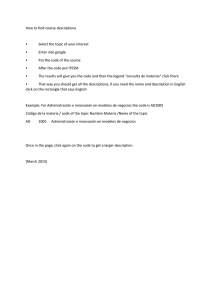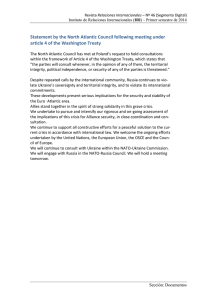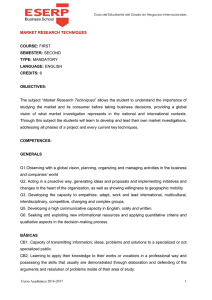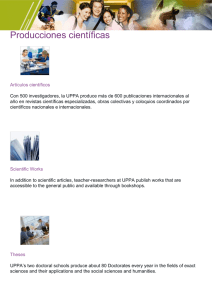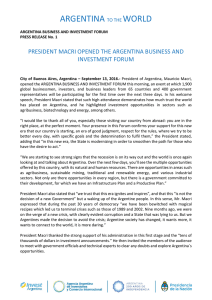Revista de Negocios Internacionales
Anuncio
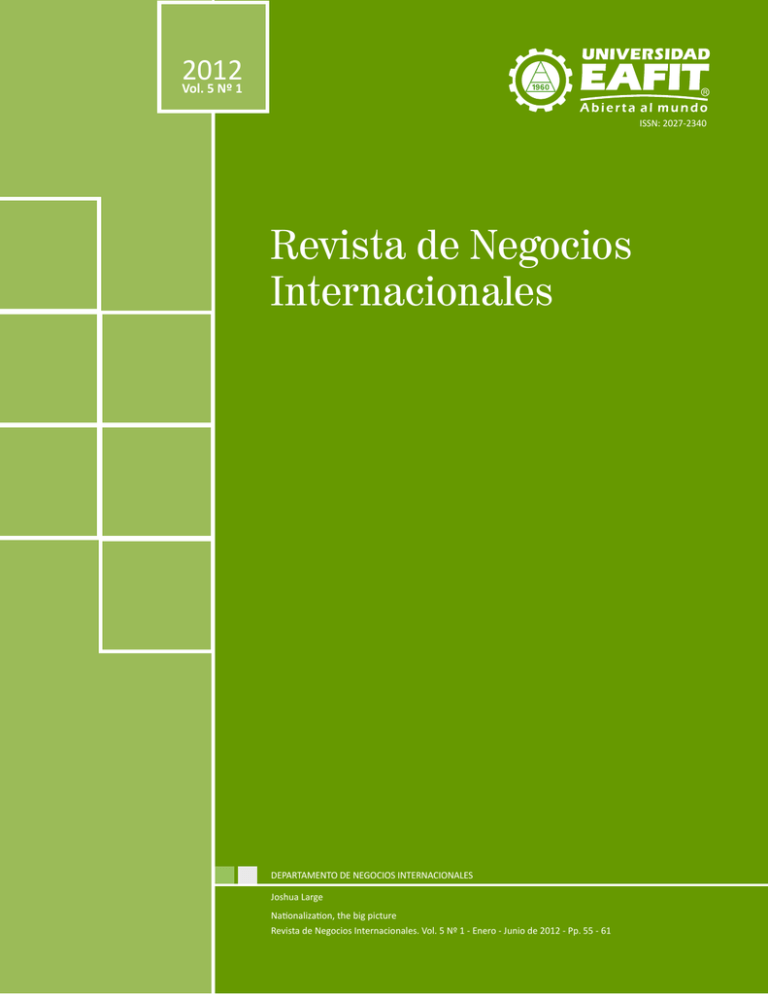
INTERNATIONALIZATION CASES CASOS DE INTERNACIONALIZACIÓN 2012 Vol. 5 Nº 1 54 Aplicación de teorías de internacionalización a “La Casa Arana” (Peruvian Amazon Company) RAMÍREZ MEJIA, Sara · CORREA ARANZAZU, Andrea · RAMÍREZ MEJÍA, Eliana · HERNÁNDEZ BAENA, Daniela ISSN: 2027‐2340 Pineda Camacho, R., & Thomson, N. (1913). El Libro Rojo del Putumayo: Precedido de una Introducción sobre el verdadero escándalo de las atrocidades del Putumayo. Bogotá: Arboleda y Valencia. Topik, S., Marichal, C. & Frank Z. (2006). From Silver to Cocaine. Latin American Revista de Negocios Internacionales Commodity Chains and the Building of the World Economy, 1500-2000. North Carolina: Duke University Press. Vargas-Llosa, M. (2010). El Sueño del Celta. Madrid: Alfaguara. Vernon, R. (1966) International investment and international trade in the product cycle. Quarterly Journal of Economics, 80: 190-207 Villamil, A. (1928). “Regiones Amazónicas. Memorándum sobre los Problemas que Confrontará Colombia al Iniciar la Organización Administrativa y Colonización de ellas.” A. N. C. S. R. F. M. G. S. 1ª, t.966, fols. P 512-526. DEPARTAMENTO DE NEGOCIOS INTERNACIONALES Joshua Large REVISTA DE NEGOCIOS INTERNACIONALES Vol. 5 Nº 1. Pp. 44 - 54 Nationalization, the big picture Revista de Negocios Internacionales. Vol. 5 Nº 1 - Enero - Junio de 2012 - Pp. 55 - 61 INTERNATIONALIZATION CASES CASOS DE INTERNACIONALIZACIÓN NACIONALIZACIONES / NATIONALIZATIONS 55 Analysis. Nationalization, the big picture LARGE, Joshua Nationalization, the big picture On April 16, 2012, Argentina’s president Cristina Fernández dramatically Joshua LARGE (PhD) announced that 51% of the oil company YPF was to be re-nationalized (the former state company, founded in 1922, had been privatized between 1991 and 1993). Fecha de recibido: 03/05/2012 Specifically, the government targeted the stake held by the Spanish multinational Fecha de aceptado: 08/05/2012 Repsol. The Spanish Foreign Ministry reported unsavory incidents of threats and intimidation as Argentine officials and security agents expelled Spanish executives and occupied YPF’s headquarters in Buenos Aires (Johnson). The incident was of course far from unique in South America’s recent history. Leftist governments in Venezuela, Ecuador, and Bolivia have undertaken similar nationalization projects over the last decade (indeed on May 1, Bolivia announced the expropriation of its power grid operations from the Spanish national power company, REE). But the Argentine case struck many observers as particularly cynical and portentous. Formerly, Fernández had been perceived as “a chavista-lite, harassing private business, rigging national statistics and gutting state institutions” (Economist, April 21, 2012). Now she had apparently graduated from such populist hors d’oeuvres to a main course of resource-nationalist red meat. Along with the international financial media, the Spanish government and the EU were predictably scandalized, and Repsol has naturally promised litigation. Meanwhile Colombia’s president Juan Manuel Santos, fresh from his (generally) triumphant hosting of the Summit of the Americas, was seen to palpably gloat: “here we don’t expropriate, President Rajoy,” he told the Spanish premier. “what we want is for you to feel that there are stable rules here and that we aren’t going to change those rules…. Colombia is a destination that is totally attractive for trade and is a nation in complete transformation” (Fox Business, April 19, 2012). How quickly things change. In the 1990s, while Colombia was being written off as a failed state, Argentina was taking its turn as the darling of the investment world, REVISTA DE NEGOCIOS INTERNACIONALES Vol. 5 Nº 1. Pp. 55 - 61 briefly attracting more foreign direct investment (FDI) than any other country in NACIONALIZACIONES / NATIONALIZATIONS 56 Analysis. Nationalization, the big picture LARGE, Joshua the region save Brazil. Now, as Fernández takes her turn as global capitalism’s bête noire du jour, Santos trumpets the “Colombian Comeback” from the cover of Time magazine (April 23, 2012). Fernández’s nationalization of YPF may well have been ill-advised, as it was undoubtedly a piece of vulgar political theater (the announcement was accompanied by banners depicting the old, pre-privatization YPF logo next to an image of that other great populist canard, Las Malvinas). Source: Agencia Periodista de America del Sur (APAS) http://www.prensamercosur.com.ar/apm/tapa.php Even so, Colombians would probably do well to refrain from responding with selfcongratulatory Schadenfreude (an all-too-frequent habit, as witnessed by the national obsession with Venezuela’s Hugo Chavez) and concentrate on the bigger historical and political-economic picture surrounding Latin American resource nationalism. If anything, the very swiftness of Argentina’s fall from neoliberal grace should give cautious pause. During the 1990s, the government of Carlos Menem radically reformed Argentina’s economy, instituting strict monetary and fiscal discipline, liberalizing trade, deregulating finance, eliminating foreign capital controls, and privatizing state-owned industries, YPF among them (Rodrik, 185). Eager to attract foreign investment, Argentina also signed a bilateral investment treaty (BIT) with the United States which offered considerably more robust protection to foreign investment from government regulation and/or expropriation than already provided under existing GATT law. At first these reforms appeared to work: trade boomed, investment poured in, while government spending and inflation were brought under control. But by 2000 Argentina’s economy had once again collapsed, and foreign capital duly evacuated faster than it had arrived. The REVISTA DE NEGOCIOS INTERNACIONALES Vol. 5 Nº 1. Pp. 55 - 61 government, broke and facing widespread civil unrest, was forced to retreat from NACIONALIZACIONES / NATIONALIZATIONS 57 Analysis. Nationalization, the big picture LARGE, Joshua the previous decade’s neoliberal reforms, reinstituting capital controls, freezing bank accounts, defaulting on foreign debt, and devaluing the currency. The reason for this spectacular collapse, as economist Dani Rodrik explains it, is that “domestic politics got in the way of hyperglobalization. The painful economic adjustments required by deep integration did not sit well with domestic constituencies, and politics ultimately emerged victorious” (Rodrik, 187). Policies designed to boost confidence among would-be foreign investors, in other words, helped produce economic shock that in turn undermined investor confidence. Furthermore, in beating its expedient retreat from neoliberal policy, Argentina violated its BIT with the US (re-instituted capital controls amounted to “indirect expropriation” under the treaty’s terms), thereby provoking a round of international arbitration that, when concluded, awarded some 400 million dollars in damages—to this day unpaid by Argentina—to foreign investors (Economist, February 18, 2012). In fact, the two other countries in addition to Argentina who signed so-called “Type One” BITs—those offering the most liberal terms to foreign investment—with the US during the 1990s, Ecuador and Bolivia, have also witnessed the accession of leftist governments and attendant reactionary nationalization projects (Haslam, 2010). Armed with this cautionary tale, we might briefly muse upon the current global political economy of resource nationalism. There are numerous reasons why governments expropriate foreign capital, among them the aforementioned taste for populist red meat, as well as domestic power politics and cronyism, as Hugo Chavez’s long-running battle for control of Venezuela’s oil company PDVDA— which was already state-owned but largely autonomous when he came to power—demonstrates. Nationalized companies, particularly energy companies, also serve as reliable government cash cows, even when and if they run less efficiently in state hands. Beyond the realm of such domestic concerns, however, blow the capricious winds of globalization, which occasionally threaten to upset the national edifice itself. Nationalization, in this light, is a logical buttress against the increasing volatility of global capitalism. Such defensive moves, moreover, are hardly unique to the South American “new left.” As Hal Weitzman, former Andean correspondent to the Financial Times points out in an astute new book, countries outside the region—e.g. Russia with its re-nationalization of the natural gas behemoth Gazprom in 2004—have engaged in similar nationalizing policies (though in Russia’s case this admittedly has everything to do with power politics and gangsterism and essentially nothing to do with concerns for national social welfare). Even the United States, international cheerleader for the neoliberal “Washington consensus,” nationalized the lending agencies Freddie Mac and Fannie REVISTA DE NEGOCIOS INTERNACIONALES Vol. 5 Nº 1. Pp. 55 - 61 Mae, the insurance giant AIG, and the automaker General Motors in the midst of NACIONALIZACIONES / NATIONALIZATIONS 58 Analysis. Nationalization, the big picture LARGE, Joshua the recent global financial crisis (Weitzman, 99). The last decade has also seen a proliferation of sovereign wealth funds designed to hedge against the volatility of global commodity prices (Ibid, 96-8). To this one might add the phenomenon of “agro-imperialism,” which since 2000 has seen foreign governments buy or lease at least 76 million hectares of foreign farmland (Land Portal)—a territory half the size of western Europe—in order to grow food for their domestic populations, thereby avoiding the insecurity of increasingly volatile global food prices. Furthermore, the most important emerging economies in the world, personified by the “BRIC” acronym (Brazil, Russia, India, China), are also among the leading practitioners of state capitalism. Though it has refrained from expropriating foreign enterprise, the Brazilian state retains a substantial stake in that country’s economy: 38% of industry by national stock market capitalization (Economist, Jan 21, 2012). Moreover, despite attracting more FDI than any country in the region, Brazil has not ratified a single BIT (Haslam, 1193). China, meanwhile, appears to offer those Latin American countries who would defy the Washington consensus a viable alternative. Its “no strings attached” investment policy pursues deals wherever they are deemed economically beneficial, without demands of ideological compliance (except of course it comes to relations with Taiwan) or the linking of trade to the signing of investment treaties. Deal-making with China also offers Latin American governments greater managerial control via state-to-state negotiations. Venezuela has been particularly receptive to forging deals of “mixed” enterprise (i.e. joint state-ownership), as evidenced by the series of deals struck over the last decade between PDVSA and the largest Chinese national oil company, CPNC (Iturre and Mendes, 133). Indeed, China’s eagerness to purchase South American raw materials—especially oil and other minerals, but also agricultural goods such as soy—without neoliberal preconditions has led some officials to enthusiastically trumpet the emergence of a “Beijing Consensus” (Ibid., 139). This is not to suggest that China’s voracious hunger for South American resources or the broader phenomenon of state capitalism—within which nationalization of foreign capital represents but one component—represents a panacea, or even that the “Brazilian miracle” definitively constitutes a viable middle ground between neoliberaliam and the strident resource nationalism of Venezuela and, lately, Argentina. China has little interest in purchasing South American finished goods, which asks serious questions about the long-term sustainability and capacity for broad development afforded via its custom. The unquestionably impressive expansion the Brazilian middle class over the last decade may in fact have been REVISTA DE NEGOCIOS INTERNACIONALES Vol. 5 Nº 1. Pp. 55 - 61 substantially generated by the Chinese market for Brazilian raw materials, raising NACIONALIZACIONES / NATIONALIZATIONS 59 Analysis. Nationalization, the big picture LARGE, Joshua concerns about its staying power (Rathbone, 1). And the fact that China sees no need for treaties to safeguard its foreign investments cuts both ways: its government has, for instance, nonchalantly expressed a willingness to support any of its state-owned companies’ prospective decisions to tear up money-losing derivatives contracts with foreign banks (Weitzman, 95). The current prominence of state capitalism—worth some two trillion dollars within OECD economies alone (Economist, January 21, 2012)—suggests it is far from a passing trend. In this light, Latin American resource nationalism, barring occasional overzealousness and/or act of political expediency, ought not be seen as an inherently counterproductive phenomenon, but rather one among many current strategies of shielding societies from the increasingly severe and frequent shockwaves in the global economy. How, if at all, these various strategies for managing national economies will cohere into a new global consensus—be it of Washington, Beijing, or elsewhere—remains to be seen. As the eminent development economist Jayati Ghosh put it in a recent interview, “it’s a very strange phase of capitalism [we are in], it’s very brittle…. It’s a phase of tremendous political flux I believe, and a kind of churning…. In Hindu philosophy we have this famous churning of the oceans, where good things come out and really ghastly things come out too, and finally you don’t know what will emerge” (Guardian Online, April 16, 2012). In light of such uncertainty, Colombia’s unreconstructed embrace of the neoliberal growth model would seem, at the very least, extremely risky. Perhaps the current president Santos would do well to remember the sage words of one of his predecessors, Alfonso López Pumarejo, who in 1937 remarked that “the foundation of international economic freedom lies in the recognition that when strong nations place themselves on the defensive, they act just like weak ones do, and that all of them have the right to defend themselves with their own resources” (quoted in Carr, 59). Washington is itself not above nationalizing industry when in crisis; yet it is beyond doubt that the US government and US investors will cry foul (and aggressively litigate) should Colombia stray from the neoliberal course it prescribes. Nationalization policies may be antithetical to what Washington says, but they are not, when push comes to shove, antithetical to what it does. REVISTA DE NEGOCIOS INTERNACIONALES Vol. 5 Nº 1. Pp. 55 - 61 NACIONALIZACIONES / NATIONALIZATIONS 60 Analysis. Nationalization, the big picture LARGE, Joshua References Carr, E.H. (2001) [1939]. The Twenty Years Crisis. London: Palgrave Macmillan. Economist (2012) January 21, 2012. “Special Report: State Capitalism.” Economist (2012) February 18, 2012. “Come and Get Me: Argentina is putting international arbitration to the test.” Economist (2012) Apr 21st 2012. “Cristina scrapes the barrel: Nobody will suffer from the nationalisation of Argentina’s oil giant more than Argentines themselves.” Fox Business (2012) April 19, 2012.”Colombia’s Santos Assures Spain There Will Be No Expropriations.” http://www.foxbusiness.com/ news/2012/04/19/colombia-santos-assures-spain-there-will-be-noexpropriations/#ixzz1vBBkUM2t Guardian Online (2012) April 16, 2012. “Jayati Ghosh on capitalism since the financial crisis: ‘It’s a phase of tremendous political flux” http://www. guardian.co.uk/business/video/2012/apr/16/jayati-ghosh-capitalismfinancial-crisis-video Haslam, Paul Alexander (2010). “The Evolution of the Foreign Direct Investment Regime in the Americas.” Third World Quarterly 31/7. Pp 1181–1203. Iturre, Maite J. & Amado Mendes (2010). “Regional Implications of China’s Quest for Energy in Latin America.” East Asia 27. Pp. 127–143. DOI 10.1007/s12140010-9111-2. Johnson, Miles (2012) April 22, 2012. “Repsol threatens action against YPF investors.” Financial Times. http://www.ft.com/intl/cms/s/0/775a7eac-8b0d11e1-bc84-00144feab49a.html#axzz1vBFYsi80 Land Portal/Land Matrix (2012) http://landportal.info/landmatrix Rathbone, John Paul (2012) April 26, 2011. “China is now region’s biggest partner,” Financial Times, Special Report, The New Trade Routes, Latin America. P. 1. REVISTA DE NEGOCIOS INTERNACIONALES Vol. 5 Nº 1. Pp. 55 - 61 NACIONALIZACIONES / NATIONALIZATIONS 61 Analysis. Nationalization, the big picture LARGE, Joshua Rodrik, Dani (2011) The Globalization Paradox: Democracy and the Future of the World Economy. New York: W.W. Norton. Time Magazine (2012), Monday, April 23, 2012. Weitzman, Hal (2012). Latin Lessons: How South America Stopped Listening to The United States and Started Prospering. Hoboken, NJ: John Wiley & Sons. REVISTA DE NEGOCIOS INTERNACIONALES Vol. 5 Nº 1. Pp. 55 - 61
